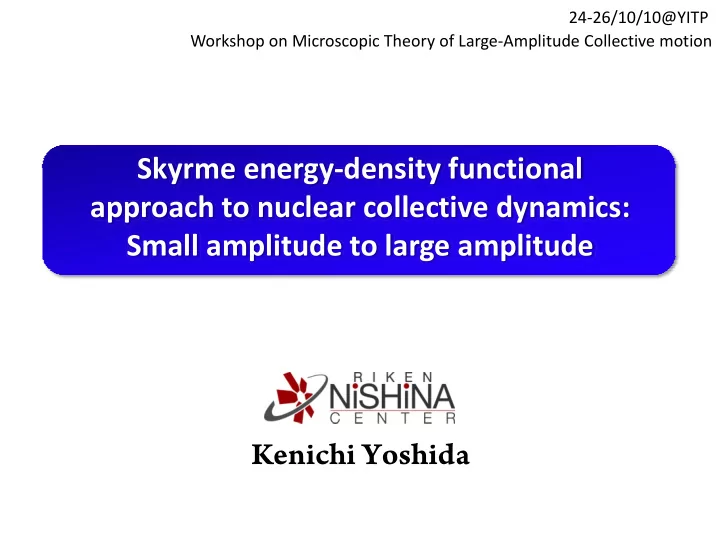

24 ‐ 26/10/10@YITP Workshop on Microscopic Theory of Large ‐ Amplitude Collective motion Skyrme energy ‐ density functional approach to nuclear collective dynamics: Small amplitude to large amplitude Kenichi Yoshida
Contents � Why DFT? � Formalism � Small ‐ amplitude collective dynamics � Applicability of DFT to nuclear dynamics � Large ‐ amplitude collective dynamics � Collectivity of neutron ‐ rich Cr isotopes � Quadrupole mass of fissioning 256 Fm � Summary
DFT for all nuclei http://www.unedf.org/
Skyrme Energy Density Functional (EDF) EDF for superfluid systems zero range: local densities finite range: gradient terms
Nuclear DFT for ground states Deformation (MeV) SkM* HFBTHO Proton Number M.V. Stoitsov et al ., PRC 68 (2003) 054312 � Weakly binding Mass explorer � Continuum coupling http://www.massexplorer.org/ Neutron Number
Skyrme-HFB-QRPA (at the equilibrium point) Minimizing the energy density The coordinate ‐ space Hartree ‐ Fock ‐ Bogoliubov theory J.Dobaczewski, H.Flocard and J.Treiner, NPA422(1984)103 A.Bulgac, FT-194-1980 (Institute of Atomic Physics, Bucharest) � Mean ‐ field Hamiltonian � Pairing field HFB equations solved directly on the 2D lattice . � 13 ‐ point formula for derivative ρ � Simple � Appropriate for describing the spatially extended structure of wave functions 0 z H.O. basis
Skyrme-HFB-QRPA (at the equilibrium point) HFB equations Quasiparticle basis (i,j,k,l) KY, N.V.Giai, PRC78 78(2008)064316 The QRPA equation in a matrix form Residual interactions � particle ‐ hole channel: We neglect only the two ‐ body Coulomb interactions. � particle ‐ particle channel: Strength distributions
Dipole responses in actinides SkM* functional HFB calc. (using 64 CPUs) Box: Cut ‐ off: QRPA calc. Cut ‐ off: # of 2qp excitation: about 50,000 Matrix elements: 590 CPU hours Diagonalization: 330 CPU hours 512 CPUs@RICC Matrix elements: 69 minutes Diagonalization: 38 minutes
Evolution of nuclear deformation in GDR 154 Sm deformed transitional 144 Sm spherical P.Carlos et al ., NPA225 A225(1974)171
Skyrme-QRPA photoabsorption cross sections KY, T.Nakatsukasa, arXiv:1008.1520 SkM* functional Intrinsic Q moment
Collective Hamiltonian approach The classical collective Hamiltonian in 1+2D: Requantization with the Pauli’s prescription: The collective Schr ö dinger equation: Collective wf in the Lab. frame Collective wf in the intrinsic frame
Skyrme-EDF based Collective Hamiltonian � The coordinate ‐ space Hartree ‐ Fock ‐ Bogoliubov theory with constraint � Mean ‐ field Hamiltonian � Pairing field At each point, we define the vacuum; and the field operator;
Skyrme-EDF based Collective Hamiltonian � The local QRPA on top of the constrained HFB state QRPA equation in the PQ representation Thouless ‐ Valatin moment of inertia
Neutron-rich Cr isotopes around N=40 Skyrme ‐ HFB with SkM* Volume ‐ pairing: H.Oba and M.Matsuo, PTP120 120(2008)143
Collectivity of neutron-rich Cr isotopes Exp.: 58 Cr, 60 Cr:S.Zhu et al., PRC74(2006)064315 62 Cr:N.Aoi et al., PRL102(2009)012502 64 Cr: A.Gade et al.,PRC81(2010)051304R
Effects of time-odd components in mean fields
Fission pathway in 256 Fm Skyrme ‐ HFB with SkM* Mixed ‐ pairing Comparison with HFODD A.Baran et al ., arXiv:1007.3763
Collective inertia on fission pathway in 256 Fm � Local QRPA mass � Cranking mass: � ATDHFB ‐ C: Baran et al.
Summary � Applicability of Skyrme EDFs to excited states First application to photoabsorption cross sections in rare ‐ earth nuclei with shape transitions � Shape changes in neutron ‐ rich Cr isotopes around N=40 Low ‐ lying states well described in the framework of the Skyrme EDF ‐ based collective Hamiltonian approach Large ‐ amplitude excited 0 + states � Quadrupole mass of 256 Fm First calculation of the quadrupole vibrational mass of 256 Fm including the time ‐ odd components of mean fields
Acknowledgements � Collaborations with Nguyen Van Giai (IPNO) Takashi Nakatsukasa (RNC) for the Skyrme ‐ EDF based deformed QRPA Nobuo Hinohara (RNC) for the collective Hamiltonian approach � Facilities T2K-Tsukuba
Recommend
More recommend